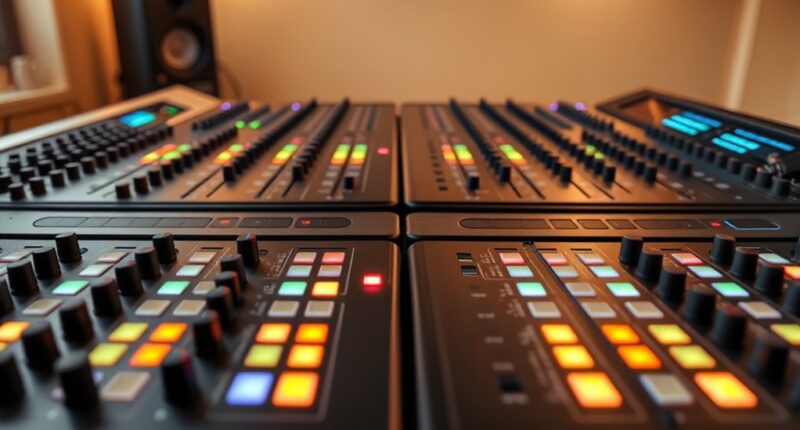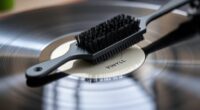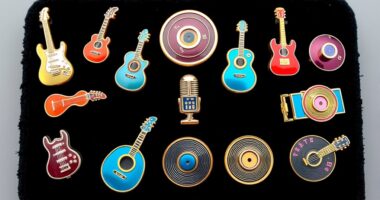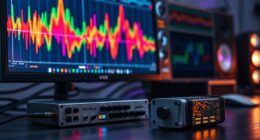If you’re looking for the 14 best FaderPort mixing controllers for seamless audio control in 2025, I’ve got you covered. These range from compact USB models like the FaderPort 2 to multi-channel controllers like the FaderPort 16, offering motorized faders, advanced automation, and broad DAW compatibility. They’re built durable for professional workflows and versatile for studio or live use. Keep going, and you’ll discover detailed insights to help you choose the perfect control surface.
Key Takeaways
- Overview of top FaderPort controllers designed for precise DAW control and automation in 2025.
- Comparison of compact and multi-channel models, highlighting features like motorized faders and compatibility.
- Pros and cons including build quality, usability, and limitations for different studio setups.
- Compatibility with major DAWs and integration options such as Mackie Control and HUI protocols.
- Practical considerations for choosing the best controller based on size, portability, and workflow needs.
PreSonus FaderPort USB Control Surface Bundle

If you’re looking for a compact yet powerful control surface to enhance your DAW workflow, the PreSonus FaderPort USB Control Surface Bundle is an excellent choice. Its touch-sensitive 100mm motorized fader delivers precise volume automation and quick mixes. The large 360° push-button encoder handles panning and plugin tweaks effortlessly. With extensive transport controls—play, stop, record, loop—it keeps your workflow smooth. Compatible with popular DAWs like Ableton Live, Pro Tools, and FL Studio, it connects via USB and is powered externally. This bundle also includes accessories like a footswitch and cable organizers, making it a versatile, all-in-one solution for any studio setup.
Best For: home, project, and mobile music producers seeking an intuitive, tactile control surface to streamline DAW workflows and enhance automation.
Pros:
- Compact design with a single, motorized 100mm fader for precise volume control
- Extensive transport and control functions, including a large encoder for panning and plugin adjustments
- Compatible with popular DAWs like Ableton Live, Pro Tools, and FL Studio, supporting USB connectivity
Cons:
- Limited to controlling up to 8 tracks via dedicated buttons, which may restrict larger session management
- Lack of motorized control for the master fader and scene launching features in Ableton Live
- Some users experience encoder jumps and limited integration with certain DAWs despite firmware updates
PreSonus FaderPort 16-Channel Production Controller
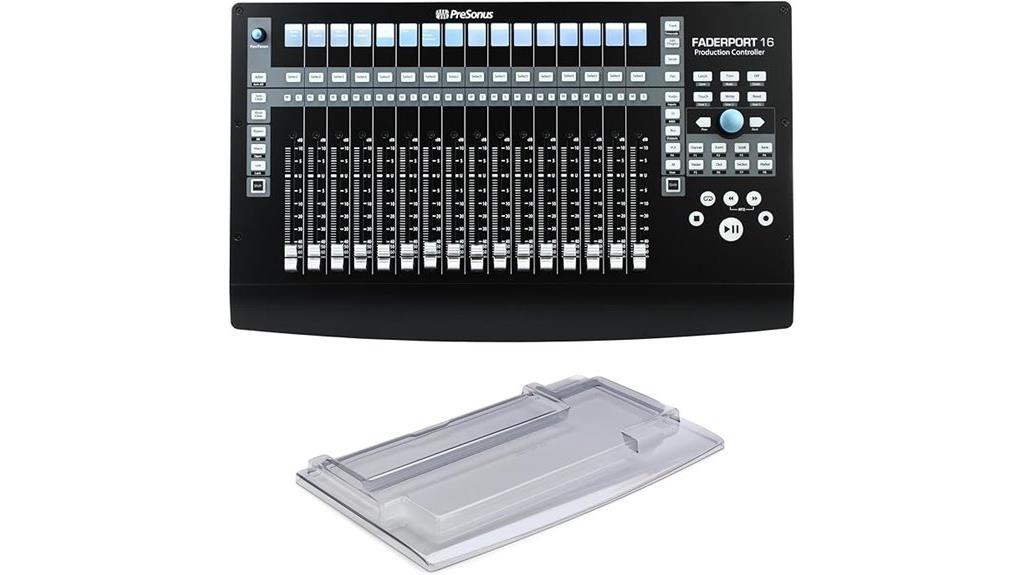
The PreSonus FaderPort 16-Channel Production Controller is ideal for producers, engineers, and musicians who demand precise, hands-on control over their DAW sessions. With 16 touch-sensitive, motorized 100mm faders, it offers accurate level adjustments and control over plug-ins and bus sends. The high-definition scribble strips make channel identification quick and easy, while dedicated buttons handle transport, undo/redo, solo/mute, track arming, and automation modes. The Session Navigator simplifies navigation through complex sessions, enabling fast track scrolling and channel banking. Built for durability and seamless integration via USB, it’s perfect for boosting productivity in both professional and home studios.
Best For: producers, engineers, and musicians seeking precise, hands-on control over their DAW sessions for efficient music production and mixing.
Pros:
- Equipped with 16 touch-sensitive, motorized 100mm faders for accurate level control
- High-definition scribble strips for quick channel identification
- Dedicated buttons for transport, undo/redo, solo/mute, and automation modes to streamline workflows
Cons:
- May require a learning curve for users unfamiliar with DAW control surfaces
- Limited to DAW integration, primarily optimized for Studio One, which could reduce compatibility with other software
- The device’s size and number of controls might be overwhelming for minimalist setups
Pyle 6-Channel Bluetooth Audio Mixer with USB, XLR Mic, +48V Phantom Power
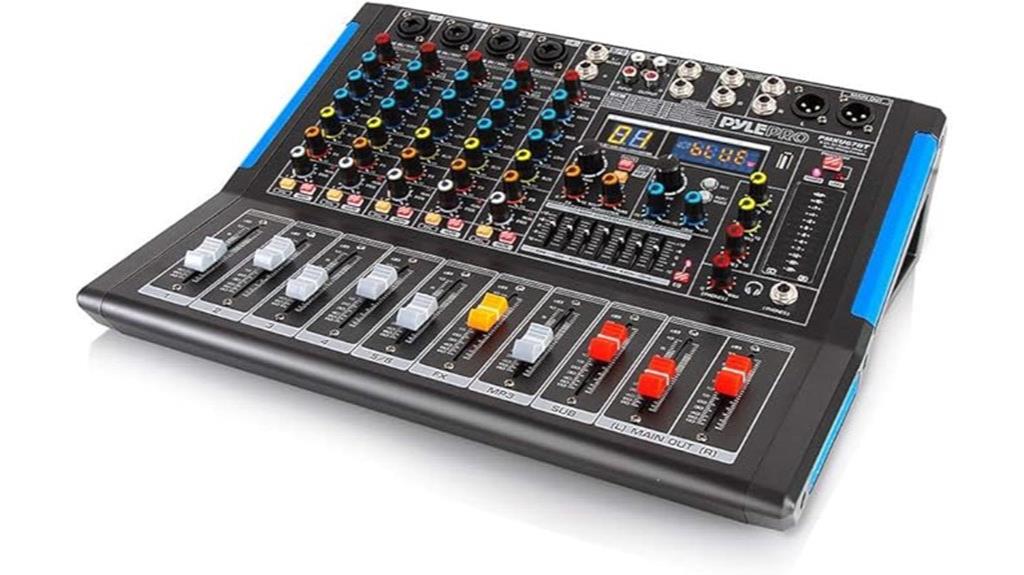
Looking for a versatile audio mixer that combines wireless convenience with professional features? The Pyle 6-Channel Bluetooth Audio Mixer with USB, XLR Mic, +48V Phantom Power fits the bill perfectly. It supports Bluetooth streaming within 15 feet, compatible with smartphones, tablets, and MP3 players. With six channels, including XLR inputs, USB interface, and various outputs, it handles multiple audio sources effortlessly. Plus, it offers +48V phantom power for microphones and 16 DSP effects for enhanced sound. Whether recording, live streaming, or mixing, this device provides flexibility and professional quality in a compact package, making it a great choice for creators at any level.
Best For: musicians, podcasters, streamers, and audio enthusiasts seeking a versatile, wireless-capable mixer with professional features in a compact design.
Pros:
- Wireless Bluetooth streaming with a 15 ft range for convenient device connection.
- Multiple input options including XLR, USB, and various 1/4’’ inputs for versatile audio sources.
- Built-in +48V phantom power and 16 DSP effects enhance microphone and sound quality.
Cons:
- Limited Bluetooth range may not suit large venues or extensive setups.
- Slightly complex interface for beginners unfamiliar with audio mixing.
- No dedicated effects editing or customization beyond the 16 DSP presets.
PreSonus FaderPort DAW Controller with Studio One Pro Software
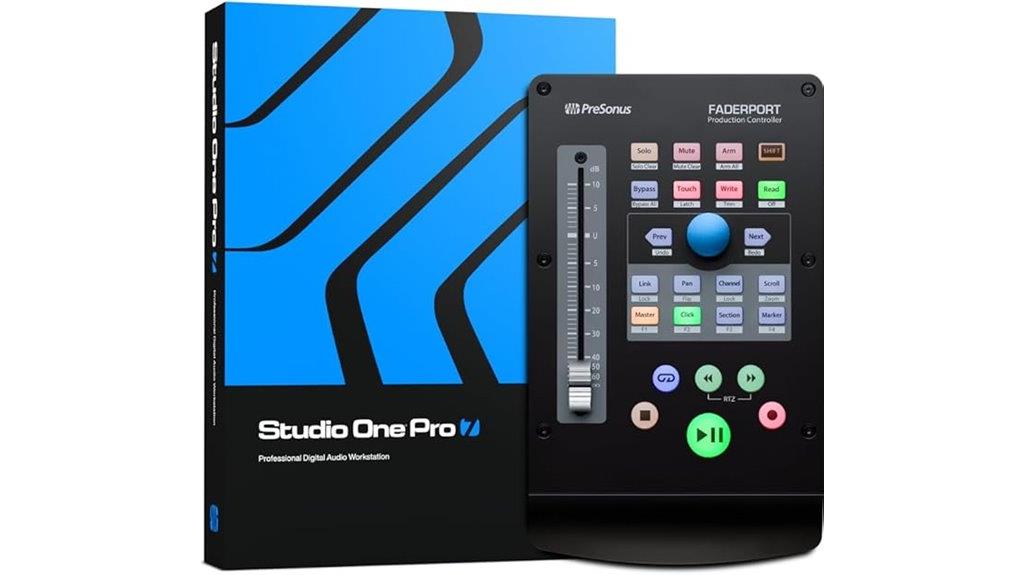
Designed for musicians and producers seeking streamlined control over their DAW, the PreSonus FaderPort V2 excels when paired with Studio One Pro Software. It features a 100 mm touch-sensitive, motorized fader, along with transport controls and a large push-button encoder for quick editing. Compatible with Mac, Windows, and iPad, it also supports other DAWs via Mackie Control emulation. The device offers over 24 buttons for functions like record, solo, mute, automation, and markers, making workflow efficient. Its seamless integration with Studio One enhances productivity, allowing one-handed operation for mixing, editing, and controlling playback. Overall, it’s a compact, versatile control surface ideal for professional and home studios.
Best For: musicians and producers seeking a streamlined, integrated control surface primarily for Studio One Pro and compatible DAWs to enhance workflow and mixing efficiency.
Pros:
- Seamless integration with Studio One Pro and multiple DAWs via Mackie emulation
- Intuitive one-handed operation with dedicated transport, automation, and control buttons
- High build quality with a motorized 100 mm touch-sensitive fader for precise adjustments
Cons:
- Cumbersome channel navigation and small LCD scribble strips hinder quick identification and control
- Basic audio interface features with consumer-grade DACs and unbalanced outputs limit professional audio fidelity
- Track arming and certain hardware controls are inefficient, and some physical controls are poorly implemented
PreSonus FaderPort USB Control Surface Bundle
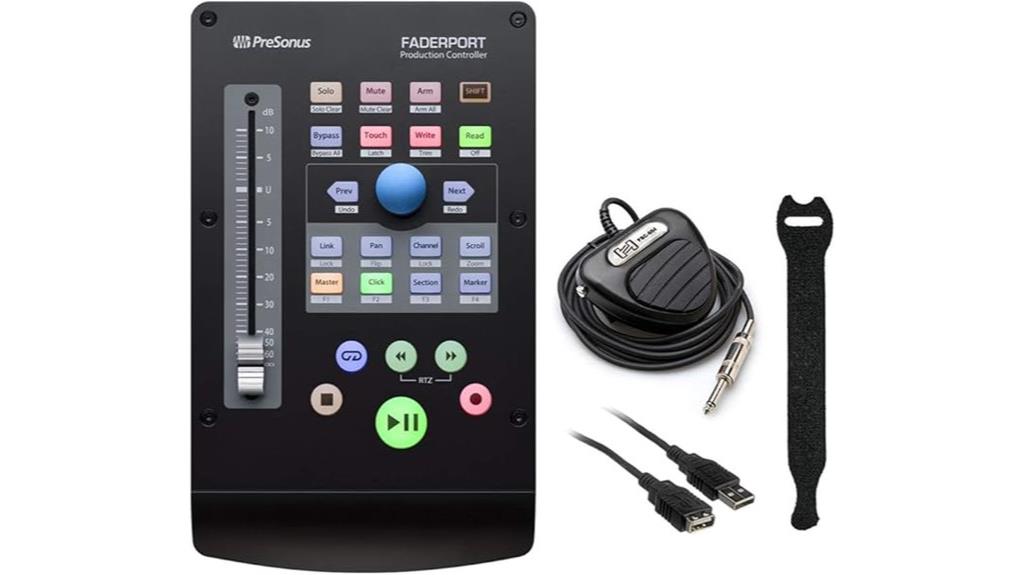
If you’re seeking precise and tactile control over your DAW, the PreSonus FaderPort USB Control Surface Bundle is an excellent choice. Its 2nd-generation design features a touch-sensitive 100mm motorized fader for accurate volume automation and quick rough mixes. The large 360° push-button encoder handles panning and plugin adjustments effortlessly. With all-encompassing transport controls—play, stop, record, loop—it streamlines workflow. The bundle includes a 12 VDC power supply, a footswitch, cable organizers, and extension cables, making setup easy. Compatible with popular DAWs like Ableton Live, Pro Tools, and FL Studio, it’s perfect for enhancing productivity in home or mobile studios.
Best For: Home, project, and mobile studio producers seeking precise tactile control and automation for their DAWs.
Pros:
- Provides accurate, touch-sensitive 100mm motorized fader for detailed volume automation
- Includes a large 360° push-button encoder for effortless panning and plugin adjustments
- Compact, lightweight design with comprehensive transport controls enhances workflow efficiency
Cons:
- Limited control over more than 8 tracks via dedicated buttons
- Does not support session view launching in Ableton Live
- Master fader is not motorized, which may affect automation precision
PreSonus FaderPort 16-Channel Production Controller
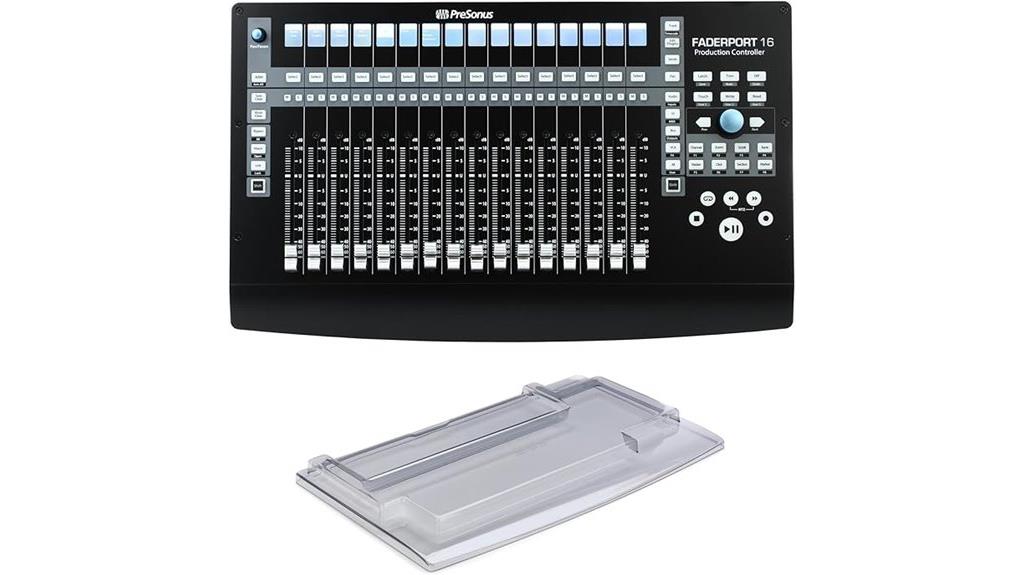
The PreSonus FaderPort 16-Channel Production Controller stands out as an ideal choice for producers, engineers, and musicians who need precise, hands-on control over their DAW sessions. With 16 touch-sensitive, motorized 100mm faders, it offers accurate level adjustments and plug-in control. Its high-definition scribble strips make channel identification quick and easy. Dedicated buttons handle transport, undo/redo, solo/mute, track arming, and automation modes. The Session Navigator simplifies track scrolling and navigation, boosting workflow efficiency. Built with durability in mind, it connects seamlessly via USB and integrates perfectly with DAWs like Studio One, making complex sessions manageable and intuitive.
Best For: producers, engineers, and musicians seeking precise, hands-on control over their DAW sessions with a durable, feature-rich production controller.
Pros:
- Provides 16 motorized, touch-sensitive faders for accurate level adjustments
- Features high-definition scribble strips for quick channel identification
- Seamless integration with DAWs like Studio One and USB connectivity
Cons:
- May be expensive for home studio setups on a tight budget
- Limited compatibility with DAWs other than Studio One without additional configuration
- Large footprint might require substantial desk space
Faderport 16 DAW Controller
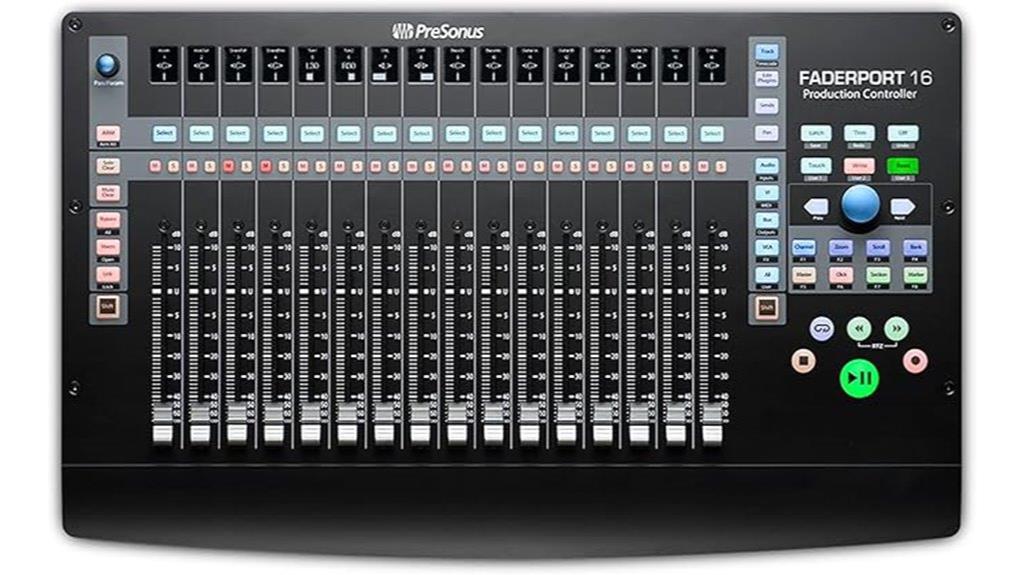
Are you looking for a professional-grade DAW controller that offers precise tactile control? The Faderport 16 by Presonus delivers with 16 motorized, sensitive faders, making it easy to synchronize with your DAW’s functions. It simplifies mixing and editing, giving you fingertip control over your sessions. Compatible with Ableton Live and supporting various DAWs, it integrates seamlessly into your workflow. Weighing just under 12 pounds and built with durable metal and plastic, it’s designed for reliable use. Whether you’re at a laptop or studio setup, the Faderport 16 provides intuitive control, making your audio production smoother and more efficient.
Best For: audio engineers, music producers, and mixing professionals seeking precise tactile control over their DAW sessions.
Pros:
- Features 16 motorized sensitive faders for accurate and intuitive mixing.
- Compatible with Ableton Live and supports a wide range of DAWs for versatile workflows.
- Durable build with metal and plastic materials, suitable for professional use and various setups.
Cons:
- Weighs nearly 12 pounds, which may be less portable for mobile setups.
- Limited to 16 channels, which might not suffice for larger mixing environments.
- Higher price point may be a consideration for budget-conscious users.
Numark M2 2-Channel DJ Mixer
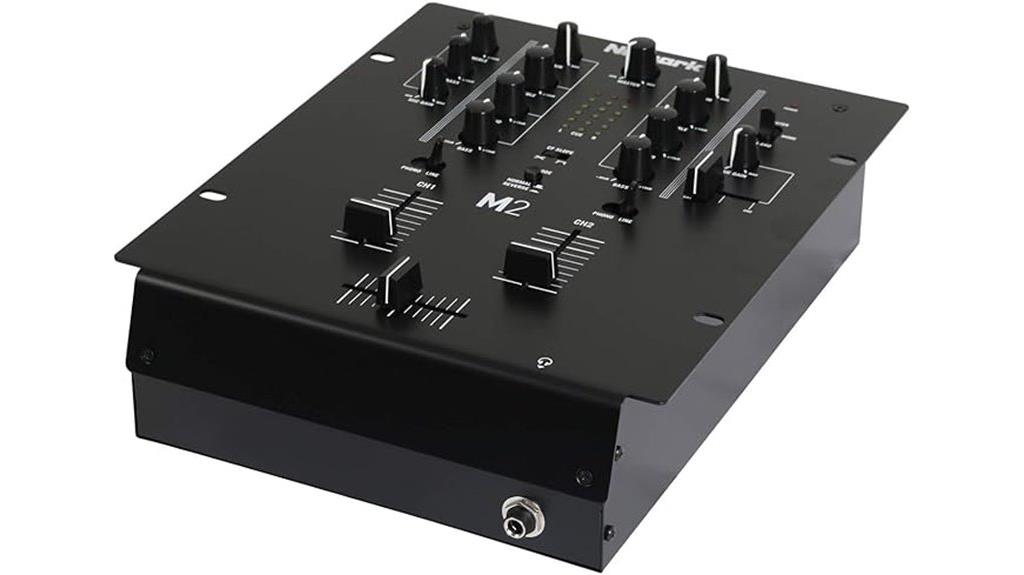
For DJs seeking a reliable, versatile mixer that handles various audio sources with ease, the Numark M2 2-Channel DJ Mixer stands out. It offers essential features like switchable RCA phono/line inputs, a 1/4-inch microphone jack, and multiple output options, making it adaptable for different setups. Its dedicated channel faders, replaceable crossfader, and three-band EQs give precise control for scratching and mixing. The sleek, durable design is portable and easy to rack-mount, perfect for gigs on the go or professional installations. Overall, the M2 balances simplicity and functionality, making it an excellent choice for both beginners and seasoned DJs.
Best For: DJs of all skill levels seeking a reliable, versatile mixer with essential features for various audio sources and setup environments.
Pros:
- Offers comprehensive connectivity options including switchable RCA phono/line inputs and a microphone jack
- Features a replaceable crossfader with reverse and slope controls for customized scratching and mixing
- Sleek, durable, and portable design suitable for mobile gigs and professional installations
Cons:
- Limited to two channels, which may not suit more complex setups requiring additional inputs
- Absence of digital connectivity options such as USB or MIDI
- Basic feature set compared to higher-end mixers with advanced effects and digital controls
PreSonus FaderPort USB Control Surface with LyxPro Headphones
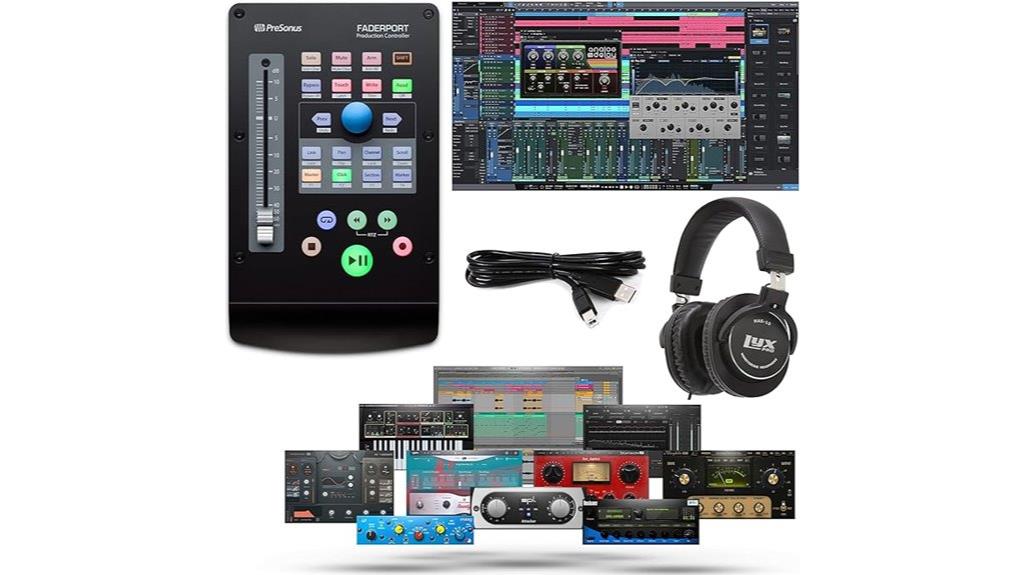
Looking to streamline your mixing workflow with precise control and reliable monitoring? The PreSonus FaderPort USB Control Surface offers a high-quality, motorized 100mm fader and a versatile 360-degree push-button encoder, supporting various DAWs including Studio One, Logic Pro X, Cubase, and Ableton Live. Its intuitive transport controls, automation features, and session management tools help speed up your sessions. While it’s compatible with Mac and Windows via USB, setup can be tricky, and some users report missing accessories like headphones. Paired with LyxPro headphones, it provides solid monitoring, making it a dependable choice for those seeking hands-on control.
Best For: musicians, producers, and audio engineers seeking precise hands-on control and automation capabilities for their DAW sessions.
Pros:
- High-quality 100mm motorized fader for accurate volume and automation control
- Wide DAW compatibility including Studio One, Logic Pro X, Cubase, and Ableton Live
- Intuitive transport and session management features to streamline workflow
Cons:
- Setup can be complicated, especially on older or incompatible OS versions
- Some users report challenges with registration and missing accessories like headphones
- Mixed customer reviews indicate potential reliability or compatibility issues
Depusheng MX6 6 Channel Sound Mixer Audio Mixing Console
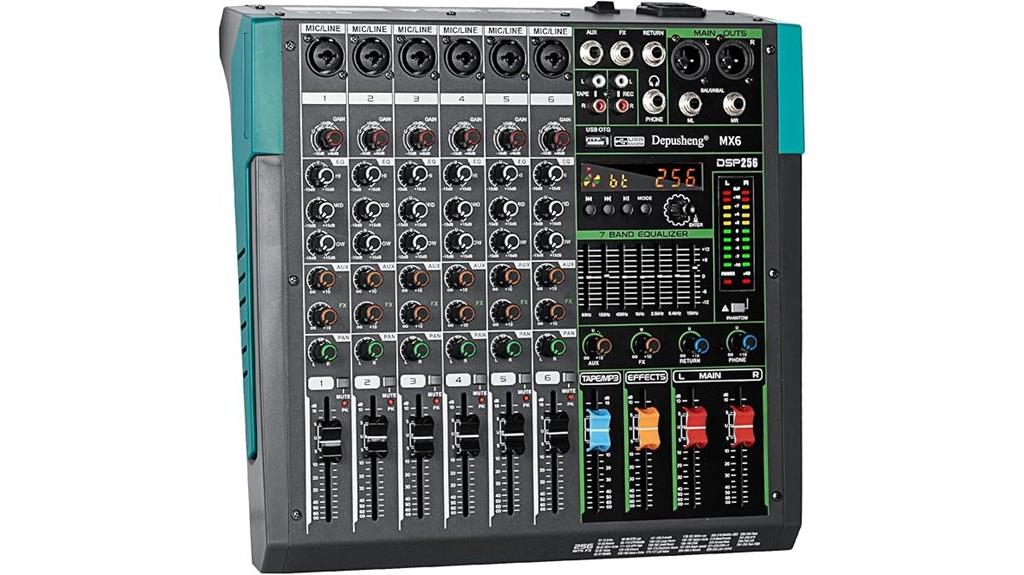
The Depusheng MX6 6 Channel Sound Mixer Audio Mixing Console is an excellent choice for both amateur and professional audio setups, thanks to its versatile connectivity options and advanced effects. It offers six channels with XLR, 6.35mm, and RCA inputs, plus XLR outputs, making it adaptable for various applications. The built-in DSP effects with 256 reverberation adjustments and a rotary compressor enable real-time sound shaping, enhancing vocal clarity and bass strength. With a USB connection for recording and playback, plus MUTE buttons and MP3 support, it simplifies live performances, KTV, or studio work. Overall, the MX6 combines powerful features in a compact, user-friendly design.
Best For: musicians, event organizers, and audio professionals seeking a versatile, easy-to-use sound mixer suitable for live performances, recording, and broadcasting.
Pros:
- Multiple input options including XLR, 6.35mm, and RCA for flexible connectivity
- Advanced DSP effects with 256 reverberation adjustments for customized sound quality
- Built-in USB interface supports recording and playback directly to a computer
Cons:
- May be complex for complete beginners without prior audio mixing experience
- Limited to 6 channels, which might not suffice for larger setups
- Requires phantom power (48V) for condenser microphones, which could necessitate additional equipment
M-VAVE Wireless MIDI Controller Mixer with Bluetooth and 8 Knobs
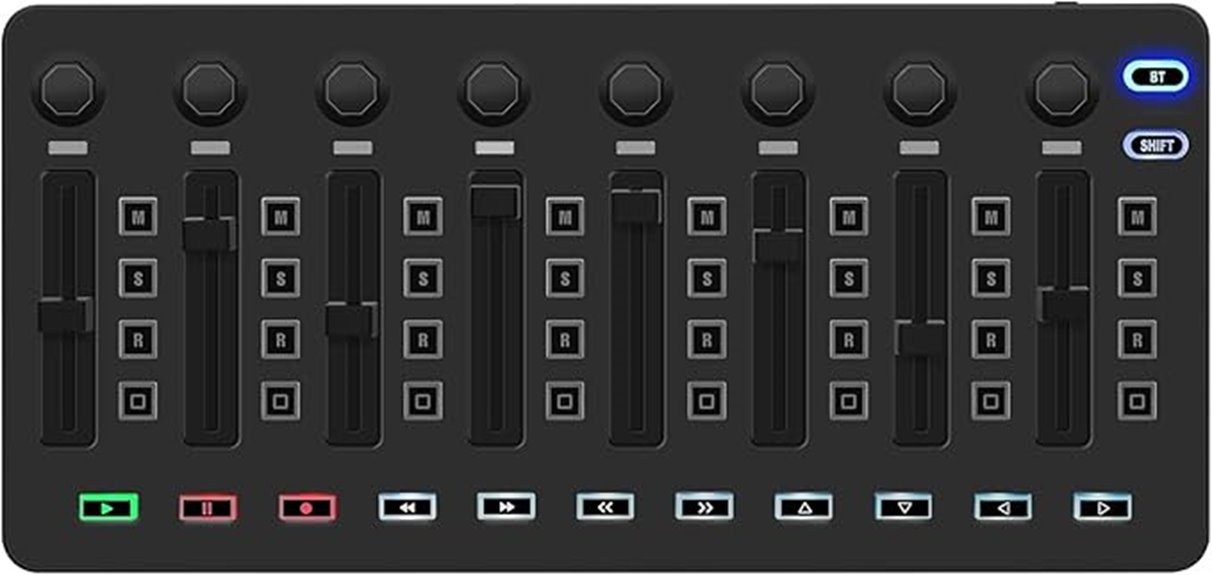
If you need a portable, wireless MIDI controller that combines precision with ease of use, the M-VAVE Wireless MIDI Controller Mixer is an excellent choice. It offers stable Bluetooth connectivity with low latency, ensuring uninterrupted music creation and seamless integration with leading DAWs—no manual MIDI mapping needed. Its compact design and rechargeable battery deliver up to 16 hours of use, perfect for on-the-go sessions. The soft backlit buttons and eight customizable 360-degree rotary encoders provide precise control and visual feedback. Plus, it comes with music production software, making it a versatile tool for both beginners and pros seeking personalized, mobile music setup.
Best For: musicians, producers, and DJs seeking a portable, wireless MIDI controller with customizable controls and seamless DAW integration for on-the-go music creation.
Pros:
- Wireless Bluetooth connection with low latency for stable, uninterrupted music production
- Compact, lightweight design with a rechargeable battery offering up to 16 hours of use
- Eight customizable 360-degree rotary encoders and soft backlit buttons for precise, silent control
Cons:
- May require initial setup or software configuration for optimal customization
- Limited to MIDI control functions; does not include built-in sound generation
- Compatibility depends on software and operating system support, which may vary
Vangoa Wireless MIDI Controller Mixer with 8 Channel Faders and Knobs
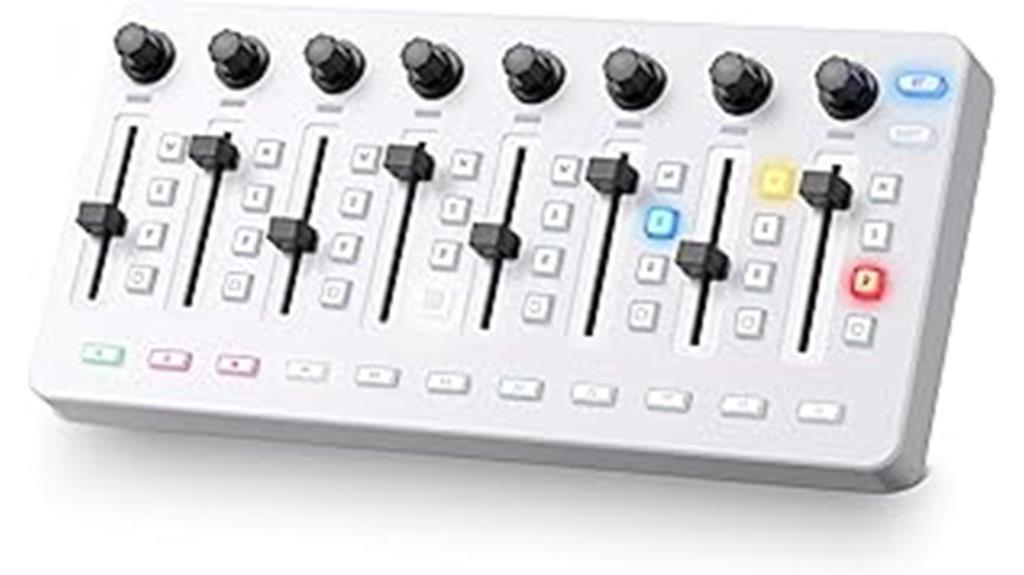
For musicians and producers seeking a portable, customizable MIDI control surface, the Vangoa Wireless MIDI Controller Mixer stands out with its 8 diamond-shaped faders and 8 assignable knobs. It features 43 backlit buttons, making it easy to trigger beats, effects, and sound parameters. Compatible with Windows, Mac, iOS, and Android, it’s perfect for studio, stage, or on-the-go use. Weighing just 12.8 ounces, it’s lightweight and sturdy, with a sleek acrylic build. The device supports Bluetooth and USB MIDI, allowing flexible connectivity. Fully programmable via user-friendly software, it offers extensive control over DAWs and software instruments, making it a versatile addition to any setup.
Best For: musicians, producers, and audio professionals seeking a portable, customizable MIDI controller for studio, stage, or on-the-go use.
Pros:
- Fully programmable with user-friendly software, allowing extensive customization.
- Supports multiple operating systems including Windows, Mac, iOS, and Android, offering versatile connectivity options.
- Compact and lightweight design with sturdy build quality, ideal for travel and live performances.
Cons:
- Limited fader length and rattling sound may affect fine-tuning precision.
- Bluetooth connectivity can be inconsistent or problematic for some users.
- Lacks MIDI out ports, restricting hardware integration to USB MIDI only.
M-VAVE Wireless Midi Controller Mixer with Bluetooth, 8 Knobs, and Software
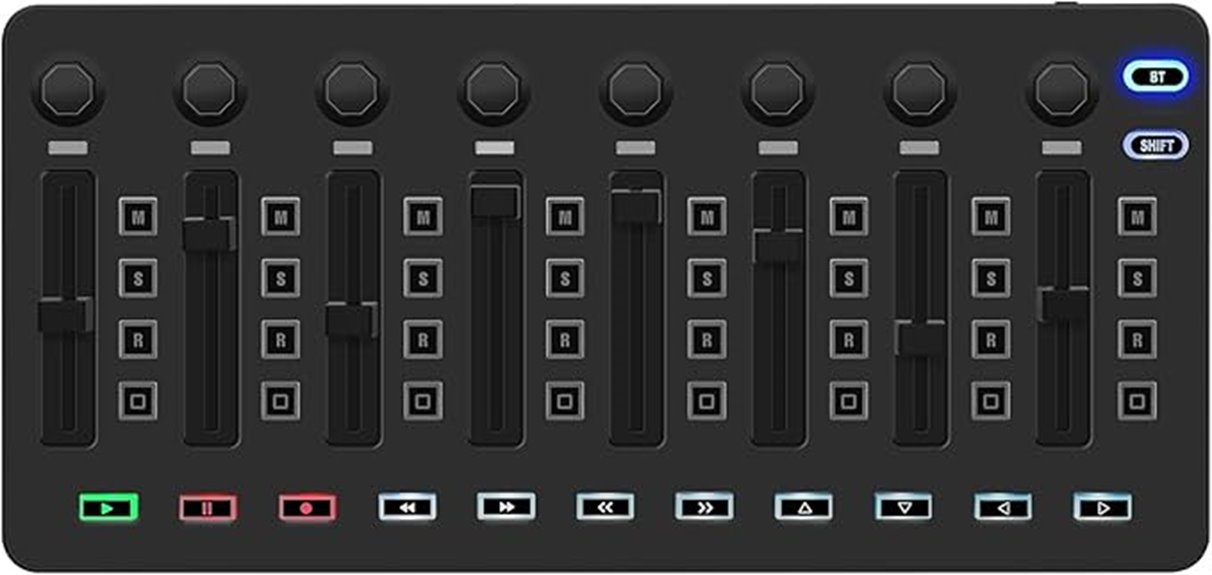
Designed for musicians and producers on the move, the M-VAVE Wireless Midi Controller Mixer offers seamless wireless connectivity with low latency, ensuring uninterrupted music creation. Its stable Bluetooth connection works smoothly with leading DAWs, eliminating manual MIDI mapping for a streamlined workflow. The compact design, coupled with a built-in rechargeable battery providing 16 hours of use, makes it perfect for studio sessions, coffee shops, or travel. The interface features soft backlit silicone buttons, eight customizable 360-degree knobs, and indicator lights for quick visual feedback. Plus, it comes with music production software, enabling personalized controls and versatile sound shaping, ideal for both beginners and pros.
Best For: musicians and producers seeking a portable, wireless MIDI controller with customizable controls and software integration for on-the-go music production.
Pros:
- Wireless Bluetooth connectivity with low latency ensures smooth, uninterrupted music creation.
- Compact, portable design with a built-in rechargeable battery providing up to 16 hours of use.
- Customizable controls and included software offer versatile sound shaping for both beginners and professionals.
Cons:
- Limited to 8 knobs, which may not be sufficient for complex setups requiring more controls.
- Requires Bluetooth compatibility and may have connectivity issues with older devices.
- Some users might find the software customization options complex initially.
Audio Mixer, DJ Controller Mixer with 6 Channels for PC and Professional Use
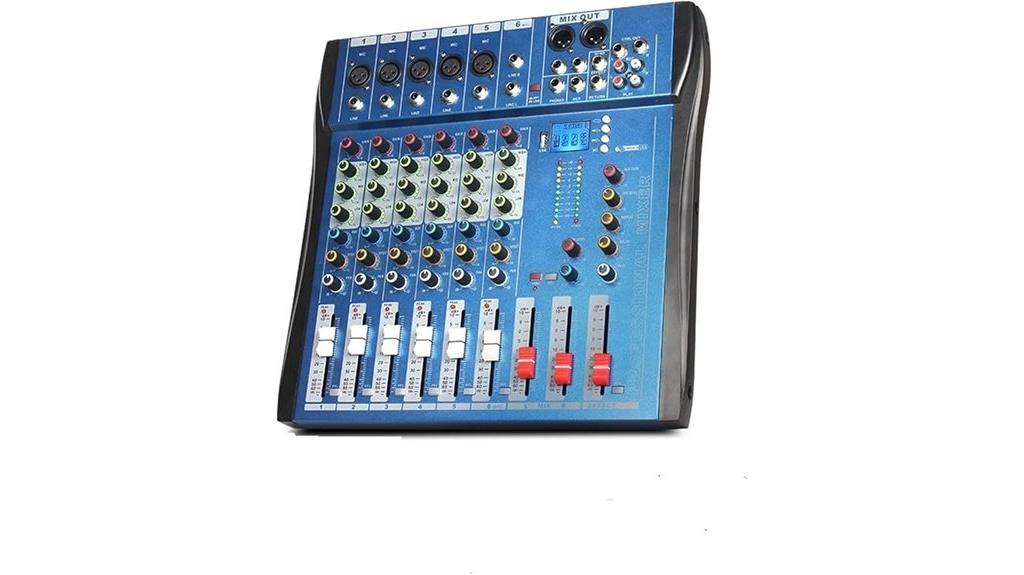
The FaderPort Mixing Controllers excel in professional audio environments where precise control over multiple channels is essential. This 6-channel DJ controller and audio mixer offers high-quality sound with studio-grade Class A D PRE amps, delivering rich bass and clear highs. The included 3-band EQ and high-pass filters give me full control over my mixes, while onboard SPX digital effects add creative options. Its rugged metal chassis ensures durability, and LED level meters help me monitor levels accurately. Designed for PC and professional use, it’s perfect for lively performances, studio work, or live mixing, providing reliable, seamless control without the need for USB connectivity.
Best For: professional DJs, audio engineers, and studio owners seeking a durable, high-quality 6-channel mixer with advanced control features for PC and live performances.
Pros:
- Studio-grade Class A D PRE amps deliver rich, natural sound with clear highs and deep bass
- Rugged, impact-resistant metal chassis ensures long-term durability
- Onboard SPX digital effects and precise LED level metering enhance creative control and monitoring
Cons:
- No USB connectivity limits direct digital integration with computers
- Might be more complex for beginners due to multiple controls and features
- Slightly heavier and bulkier compared to compact mixers, affecting portability
Factors to Consider When Choosing Faderport Mixing Controllers
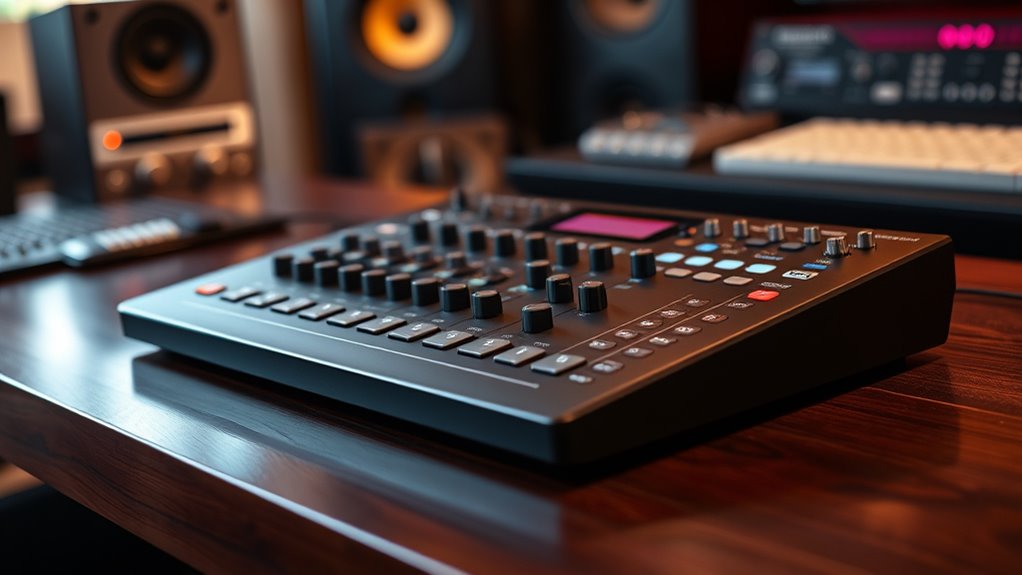
When selecting a FaderPort controller, I consider how well it works with my DAW and whether it has enough faders for my workflow. I also think about whether motorized or fixed faders suit my needs and the build quality to guarantee longevity. Finally, I evaluate control features and layout to make sure it’s intuitive and easy to use during sessions.
Compatibility With DAWS
Choosing the right FaderPort controller depends heavily on whether it works smoothly with your preferred DAW. I recommend verifying that the device supports your software, whether it’s Ableton Live, Pro Tools, or Studio One, to guarantee seamless integration. It’s also important to check if the FaderPort emulates industry-standard protocols like Mackie Control Universal or HUI, which most DAWs recognize for full functionality. Compatibility with your operating system—Windows, macOS, or Linux—is vital to avoid connection issues and to access all features. Additionally, I suggest confirming that firmware updates are available, so the controller stays compatible with the latest DAW versions. Finally, determine if the control surface offers native support or relies on third-party software, as native support typically provides more reliable and richer integration.
Number of Faders Needed
Selecting the right number of faders depends on your workflow and how many tracks you need to control at once. If you’re working on large projects with multiple tracks, a controller with 16 or 24 faders helps manage everything without constant switching, boosting efficiency. For solo artists or small studios, 8 or fewer faders offer a compact, budget-friendly option that still provides solid control. Some controllers are expandable, allowing you to add more faders as your needs grow, which is useful if your projects evolve. Think about your typical session size and how complex your workflow is. Choosing a controller with the appropriate number of faders ensures you have enough control without overpaying for unnecessary features.
Motorized vs. Fixed Faders
Motorized faders automatically move in sync with your DAW automation, offering precise visual feedback and making adjustments more intuitive. This feature is vital when automating complex mixes, as it keeps fader positions accurate during playback, reducing guesswork. Fixed faders, on the other hand, require manual movement and don’t reflect automation changes visually, which can slow down workflow. While motorized faders tend to be more expensive and complex, they excel in dynamic, automation-heavy environments. Fixed faders are simpler, more affordable, and less prone to mechanical issues, making them suitable for straightforward setups. If your work involves extensive automation and real-time feedback, motorized faders provide a clear advantage. For basic manual control, fixed faders are a practical, cost-effective choice.
Build Quality and Durability
When evaluating FaderPort mixing controllers, build quality and durability stand out as key factors to guarantee long-term reliable performance. A sturdy build using high-quality materials like metal chassis and reinforced components ensures the controller withstands daily use, accidental impacts, spills, and transportation. Precision-engineered faders and encoders with smooth, resistant movements contribute to consistent reliability over time. Well-designed surfaces often include dust and spill-resistant features or protective covers, allowing the controller to perform well in various environments. Additionally, strict manufacturing standards and rigorous quality control processes are essential to prevent early component failures and extend the product’s lifespan. Overall, investing in a well-built FaderPort ensures durability, reducing the need for repairs and providing peace of mind for years of seamless operation.
Control Features and Layout
Have you ever considered how the layout of a FaderPort controller affects your workflow? A well-designed control layout makes essential functions like volume, panning, automation, and transport controls easily accessible, reducing interruptions. The number and placement of faders, knobs, buttons, and encoders directly influence how effectively you manage multiple tracks simultaneously. Touch-sensitive, motorized faders offer high-resolution automation and tactile feedback, which are indispensable for precise editing. Clearly labeled controls for solo, mute, record-arm, and automation modes streamline session management and help prevent mistakes. Additionally, customizable or programmable buttons allow you to tailor the control surface to your specific needs, boosting efficiency. Overall, thoughtful layout and feature placement play a critical role in creating a seamless, intuitive mixing experience.
Size and Portability
Choosing the right size and portability for your FaderPort controller depends on your workspace and how often you need to move it. I recommend considering the physical dimensions and weight to guarantee it fits comfortably on your desk and is easy to transport. Smaller, lightweight controllers are ideal if you work on the go or perform live, as they’re more portable and easier to carry. On the other hand, larger models with multiple faders provide extensive control but can be bulky, reducing mobility and taking up more space. Look for features like detachable or foldable parts that improve portability without sacrificing functionality. Ultimately, choose a size that aligns with your workflow, especially if frequent movement between locations is part of your process.
Software Integration Capabilities
Selecting a FaderPort controller with strong software integration is essential for a smooth workflow. I look for native support or seamless compatibility with my preferred DAW, whether it’s Ableton Live, Pro Tools, or Studio One. Compatibility with industry-standard protocols like Mackie Control Universal or HUI guarantees reliable communication across different platforms. I also check if the controller offers dedicated control mapping software or firmware updates, which allow me to customize functions and enhance integration. Features like automation mode switching, parameter linking, and session management are critical for efficient editing. Additionally, I consider whether software bundles or firmware updates expand control capabilities or improve compatibility with future DAW updates. These factors help me streamline my workflow and maximize control during mixing sessions.
Price and Budget Range
When considering a Faderport controller, understanding the price and budget range is essential to making a smart investment. Prices vary widely: single-fader models typically cost between $100 and $300, while multi-fader units can range from $500 to over $2000. Budget constraints play a significant role; entry-level models are more affordable but may lack advanced features like motorized faders or extensive channel controls. Higher-priced units often offer better build quality, more precise motorized faders, and expanded control options that suit professional studios. It’s vital to assess whether the features justify the cost for your workflow and production needs. Setting a clear budget helps narrow your options, ensuring you choose a Faderport that offers the best value without overspending on unnecessary features.
Frequently Asked Questions
How Compatible Are These Controllers With Non-Presonus DAWS?
These controllers are generally compatible with non-PreSonus DAWs, but compatibility can vary. I’ve found that many work well with popular options like Ableton Live, Logic Pro, and Cubase, especially when using Mackie Control or HUI protocols. However, some features might not be fully supported, so I recommend checking the specific controller’s compatibility list and doing a quick test before committing to a workflow.
What Is the Typical Learning Curve for New Users?
The learning curve for new users is generally like climbing a gentle hill—manageable and rewarding. I found it took me a few hours to get comfortable, especially if you’re familiar with traditional mixers. The FaderPort controllers are designed with intuitive layouts, so you don’t need to be a tech wizard. With some practice, you’ll be steering your DAW with confidence, making mixing easier and more enjoyable.
Do These Controllers Support Wireless Connectivity Beyond Bluetooth?
Most FaderPort controllers primarily support Bluetooth for wireless connections, but they typically don’t go beyond that for wireless options. I’ve found that while Bluetooth is convenient, it can sometimes introduce latency issues, so I prefer wired connections for critical work. If you’re looking for more advanced wireless features, you might need to explore other brands or newer models that are designed with Wi-Fi or proprietary wireless tech in mind.
How Do These Controllers Handle Multiple Audio Interfaces Simultaneously?
These controllers typically handle multiple audio interfaces through their advanced routing and multiple input/output options. I find that many models allow you to assign different interfaces to specific channels, giving you flexible control over each one. They often include dedicated software for managing and customizing connections, making it easier to monitor and switch between multiple sources seamlessly. Overall, they’re designed to streamline complex setups efficiently.
What Are the Maintenance Requirements for Long-Term Durability?
I’ve investigated the durability of FaderPort controllers, and I believe regular maintenance is key. I recommend keeping the device clean, avoiding excessive dust buildup, and checking for firmware updates to guarantee peak performance. Gentle handling is essential, especially when plugging or unplugging cables. Periodic calibration and inspecting faders for smooth movement also help prolong lifespan. With proper care, these controllers can serve reliably for many years.
Conclusion
Choosing the right faderport mixing controller is like finding the perfect brush for a masterpiece — it transforms your sound landscape with precision and grace. Whether you prefer the sleek control of PreSonus or the versatile options from Vangoa and M-VAVE, each offers a unique palette for your audio artistry. Immerse yourself, experiment, and let your creativity flow seamlessly—because the right controller turns your studio into a symphony waiting to be played.
